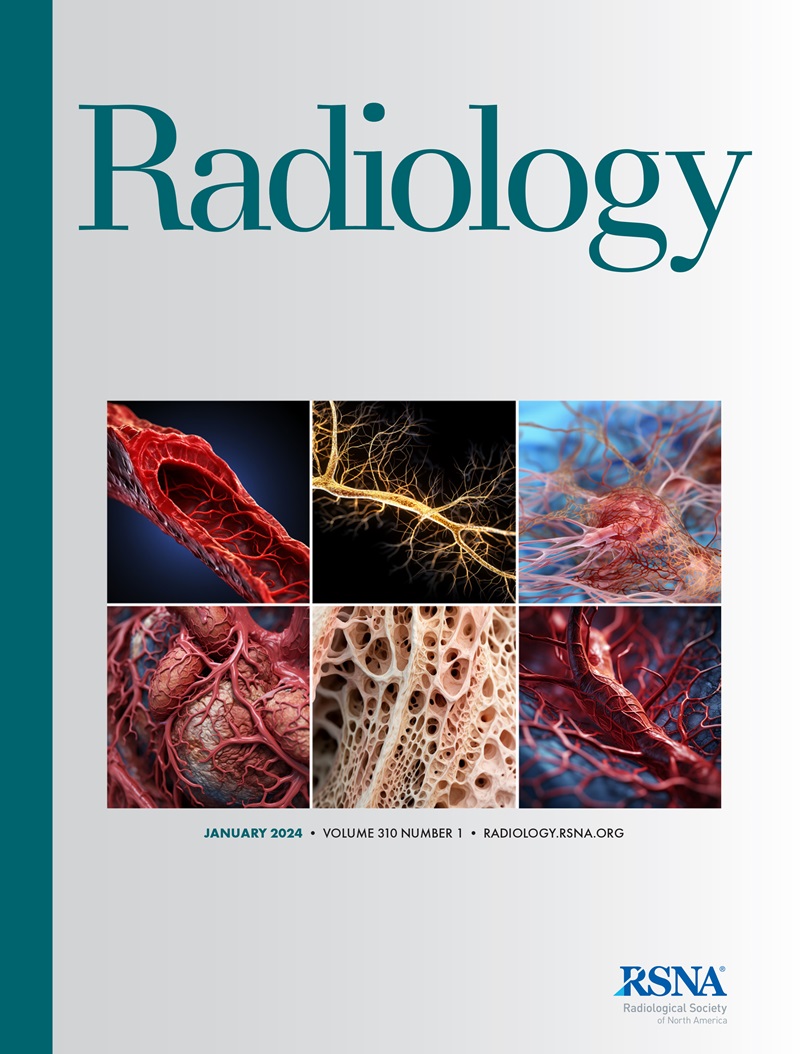Jihyun An, Rohee Park, Euichang Kim, Seong Kyun Na, Ha Il Kim, In-Hye Song, Young Seo Cho, Ji Hun Kang, Han Chu Lee, Seungbong Han, Jean-Charles Nault, Sang Hyun Choi, Ju Hyun Shim
求助PDF
{"title":"LI-RADS for Diagnosing Hepatocellular Carcinoma in Patients with Noncirrhotic Chronic Hepatitis C.","authors":"Jihyun An, Rohee Park, Euichang Kim, Seong Kyun Na, Ha Il Kim, In-Hye Song, Young Seo Cho, Ji Hun Kang, Han Chu Lee, Seungbong Han, Jean-Charles Nault, Sang Hyun Choi, Ju Hyun Shim","doi":"10.1148/radiol.241856","DOIUrl":null,"url":null,"abstract":"<p><p>Background The Liver Imaging Reporting and Data System (LI-RADS) criteria have not been validated for patients with noncirrhotic chronic hepatitis C (CHC), who are at a greater risk for hepatocellular carcinoma (HCC) than the general population. Purpose To evaluate the diagnostic performance of LI-RADS category 5 (LR-5, indicating definite HCC) observations for HCC using CT and MRI in patients with noncirrhotic CHC and to compare these findings with those in patients with cirrhotic CHC. Materials and Methods This retrospective study included patients without cirrhosis with CHC with focal hepatic nodules of 1 cm or greater on dynamic CT or MRI scans who underwent pathologic confirmation at two university hospitals from August 2002 to February 2022. This group served as the test dataset. The primary outcome was the diagnostic performance of LR-5 for HCC using CT and MRI. When LI-RADS categorization differed between CT and MRI, the MRI-based classification was used as the definitive category. Results were validated using a dataset of patients with CHC from two additional hospitals based on the clinical composite reference standard. Sensitivity, specificity, and area under the receiver operating characteristic curve (AUC) were calculated. Results The test dataset comprised 458 patients (mean age, 64 years ± 9 [SD]; 350 male; 219 without cirrhosis, 239 with cirrhosis). For noncirrhotic livers, the LR-5 criteria achieved an AUC, accuracy, sensitivity, specificity, positive predictive value (PPV), and negative predictive value (NPV) of 0.90 (95% CI: 0.86, 0.93), 85.1% (95% CI: 80.6, 89.7), 82.4% (95% CI: 77.0, 87.8), 97.6% (95% CI: 93.0, 100.0), 99.4% (95% CI: 98.2, 100.0), and 54.7% (95% CI: 43.4, 65.9), respectively. The AUC for LR-5 observations in diagnosing HCC was higher in the noncirrhotic liver group compared with the cirrhotic liver group (AUC, 0.90 [95% CI: 0.86, 0.93] vs 0.79 [95% CI: 0.74, 0.84]; <i>P</i> = .002). The diagnostic performance of the LR-5 criteria for diagnosing HCC was also excellent in patients with noncirrhotic CHC in the validation dataset, which included 155 lesions from 103 patients (mean age, 68 years ± 12; 146 male). The AUC, accuracy, sensitivity, specificity, PPV, and NPV in the validation dataset were 0.91 (95% CI: 0.84, 0.97), 96.1% (95% CI: 93.1, 99.2), 82.9% (95% CI: 70.4, 95.3), 100%, 100%, and 95.2% (95% CI: 91.5, 99.0), respectively. Conclusion The diagnostic performance of LR-5 for HCC in patients with noncirrhotic CHC was comparable to that in patients with cirrhosis across various clinical settings. © RSNA, 2025 <i>Supplemental material is available for this article.</i> See also the editorial by Schöllnast in this issue.</p>","PeriodicalId":20896,"journal":{"name":"Radiology","volume":"314 3","pages":"e241856"},"PeriodicalIF":12.1000,"publicationDate":"2025-03-01","publicationTypes":"Journal Article","fieldsOfStudy":null,"isOpenAccess":false,"openAccessPdf":"","citationCount":"0","resultStr":null,"platform":"Semanticscholar","paperid":null,"PeriodicalName":"Radiology","FirstCategoryId":"3","ListUrlMain":"https://doi.org/10.1148/radiol.241856","RegionNum":1,"RegionCategory":"医学","ArticlePicture":[],"TitleCN":null,"AbstractTextCN":null,"PMCID":null,"EPubDate":"","PubModel":"","JCR":"Q1","JCRName":"RADIOLOGY, NUCLEAR MEDICINE & MEDICAL IMAGING","Score":null,"Total":0}
引用次数: 0
引用
批量引用
Abstract
Background The Liver Imaging Reporting and Data System (LI-RADS) criteria have not been validated for patients with noncirrhotic chronic hepatitis C (CHC), who are at a greater risk for hepatocellular carcinoma (HCC) than the general population. Purpose To evaluate the diagnostic performance of LI-RADS category 5 (LR-5, indicating definite HCC) observations for HCC using CT and MRI in patients with noncirrhotic CHC and to compare these findings with those in patients with cirrhotic CHC. Materials and Methods This retrospective study included patients without cirrhosis with CHC with focal hepatic nodules of 1 cm or greater on dynamic CT or MRI scans who underwent pathologic confirmation at two university hospitals from August 2002 to February 2022. This group served as the test dataset. The primary outcome was the diagnostic performance of LR-5 for HCC using CT and MRI. When LI-RADS categorization differed between CT and MRI, the MRI-based classification was used as the definitive category. Results were validated using a dataset of patients with CHC from two additional hospitals based on the clinical composite reference standard. Sensitivity, specificity, and area under the receiver operating characteristic curve (AUC) were calculated. Results The test dataset comprised 458 patients (mean age, 64 years ± 9 [SD]; 350 male; 219 without cirrhosis, 239 with cirrhosis). For noncirrhotic livers, the LR-5 criteria achieved an AUC, accuracy, sensitivity, specificity, positive predictive value (PPV), and negative predictive value (NPV) of 0.90 (95% CI: 0.86, 0.93), 85.1% (95% CI: 80.6, 89.7), 82.4% (95% CI: 77.0, 87.8), 97.6% (95% CI: 93.0, 100.0), 99.4% (95% CI: 98.2, 100.0), and 54.7% (95% CI: 43.4, 65.9), respectively. The AUC for LR-5 observations in diagnosing HCC was higher in the noncirrhotic liver group compared with the cirrhotic liver group (AUC, 0.90 [95% CI: 0.86, 0.93] vs 0.79 [95% CI: 0.74, 0.84]; P = .002). The diagnostic performance of the LR-5 criteria for diagnosing HCC was also excellent in patients with noncirrhotic CHC in the validation dataset, which included 155 lesions from 103 patients (mean age, 68 years ± 12; 146 male). The AUC, accuracy, sensitivity, specificity, PPV, and NPV in the validation dataset were 0.91 (95% CI: 0.84, 0.97), 96.1% (95% CI: 93.1, 99.2), 82.9% (95% CI: 70.4, 95.3), 100%, 100%, and 95.2% (95% CI: 91.5, 99.0), respectively. Conclusion The diagnostic performance of LR-5 for HCC in patients with noncirrhotic CHC was comparable to that in patients with cirrhosis across various clinical settings. © RSNA, 2025 Supplemental material is available for this article. See also the editorial by Schöllnast in this issue.

 求助内容:
求助内容: 应助结果提醒方式:
应助结果提醒方式:


